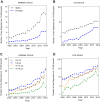Autism in England: assessing underdiagnosis in a population-based cohort study of prospectively collected primary care data
- PMID: 37090088
- PMCID: PMC10114511
- DOI: 10.1016/j.lanepe.2023.100626
Autism in England: assessing underdiagnosis in a population-based cohort study of prospectively collected primary care data
Abstract
Background: Autism has long been viewed as a paediatric condition, meaning that many autistic adults missed out on a diagnosis as children when autism was little known. We estimated numbers of diagnosed and undiagnosed autistic people in England, and examined how diagnostic rates differed by socio-demographic factors.
Methods: This population-based cohort study of prospectively collected primary care data from IQVIA Medical Research Data (IMRD) compared the prevalence of diagnosed autism to community prevalence to estimate underdiagnosis. 602,433 individuals registered at an English primary care practice in 2018 and 5,586,100 individuals registered between 2000 and 2018 were included.
Findings: Rates of diagnosed autism in children/young people were much higher than in adults/older adults. As of 2018, 2.94% of 10- to 14-year-olds had a diagnosis (1 in 34), vs. 0.02% aged 70+ (1 in 6000). Exploratory projections based on these data suggest that, as of 2018, 463,500 people (0.82% of the English population) may have been diagnosed autistic, and between 435,700 and 1,197,300 may be autistic and undiagnosed (59-72% of autistic people, 0.77%-2.12% of the English population). Age-related inequalities were also evident in new diagnoses (incidence): c.1 in 250 5- to 9-year-olds had a newly-recorded autism diagnosis in 2018, vs. c.1 in 4000 20- to 49-year-olds, and c.1 in 18,000 people aged 50+.
Interpretation: Substantial age-related differences in the proportions of people diagnosed suggest an urgent need to improve access to adult autism diagnostic services.
Funding: Dunhill Medical Trust, Economic and Social Research Council, Medical Research Council, National Institute for Health Research, the Wellcome Trust, and the Royal College of Psychiatrists.
Keywords: Autism spectrum condition; Incidence; Prevalence; Primary care; Under-diagnosis; Underdiagnosis.
© 2023 The Author(s).
Conflict of interest statement
E.O. received a post-doctoral fellowship from the Dunhill Medical Trust which funded completion of the work (grant awarded to J.S., W.M., I.P., R.C., C.C., F.H., A.C., J.M., M.R., and C.Z.). J.S. was supported by the ESRC and NIHR. M.R. was supported by the Medical Research Council and J.E.J.B. was supported by the Wellcome Trust and the Royal College of Psychiatrists. R.S. declares no support from any organisation for the submitted work. J.M. was supported by the NIHR Applied Research Collaboration (ARC) South London. WM was supported by the MRC and NIHR. The views expressed are those of the authors and not necessarily those of the NHS, NIHR, the Wellcome Trust, the Dunhill Medical Trust, the ESRC, or the MRC. All authors declare that they have no financial relationships with any organisations that might have an interest in the submitted work in the previous three years, and no other relationships or activities that could appear to have influenced the submitted work.
Figures




References
-
- American Psychiatric Association . 5th ed. American Psychiatric Association; Washington, D.C.: 2013. Diagnostic and statistical manual of mental disorders: DSM-5.
-
- Russell G., Stapley S., Newlove-Delgado T., et al. Time trends in autism diagnosis over 20 years: a UK population-based cohort study. J Child Psychol Psychiatry. 2022;63:674–682. - PubMed
-
- Brugha T.S., McManus S., Bankart J., et al. Epidemiology of autism spectrum disorders in adults in the community in England. Arch Gen Psychiatry. 2011;68:459–465. - PubMed
-
- Brugha T.S., Spiers N., Bankart J., et al. Epidemiology of autism in adults across age groups and ability levels. Br J Psychiatry. 2016;209:498–503. - PubMed
LinkOut - more resources
Full Text Sources
Research Materials

